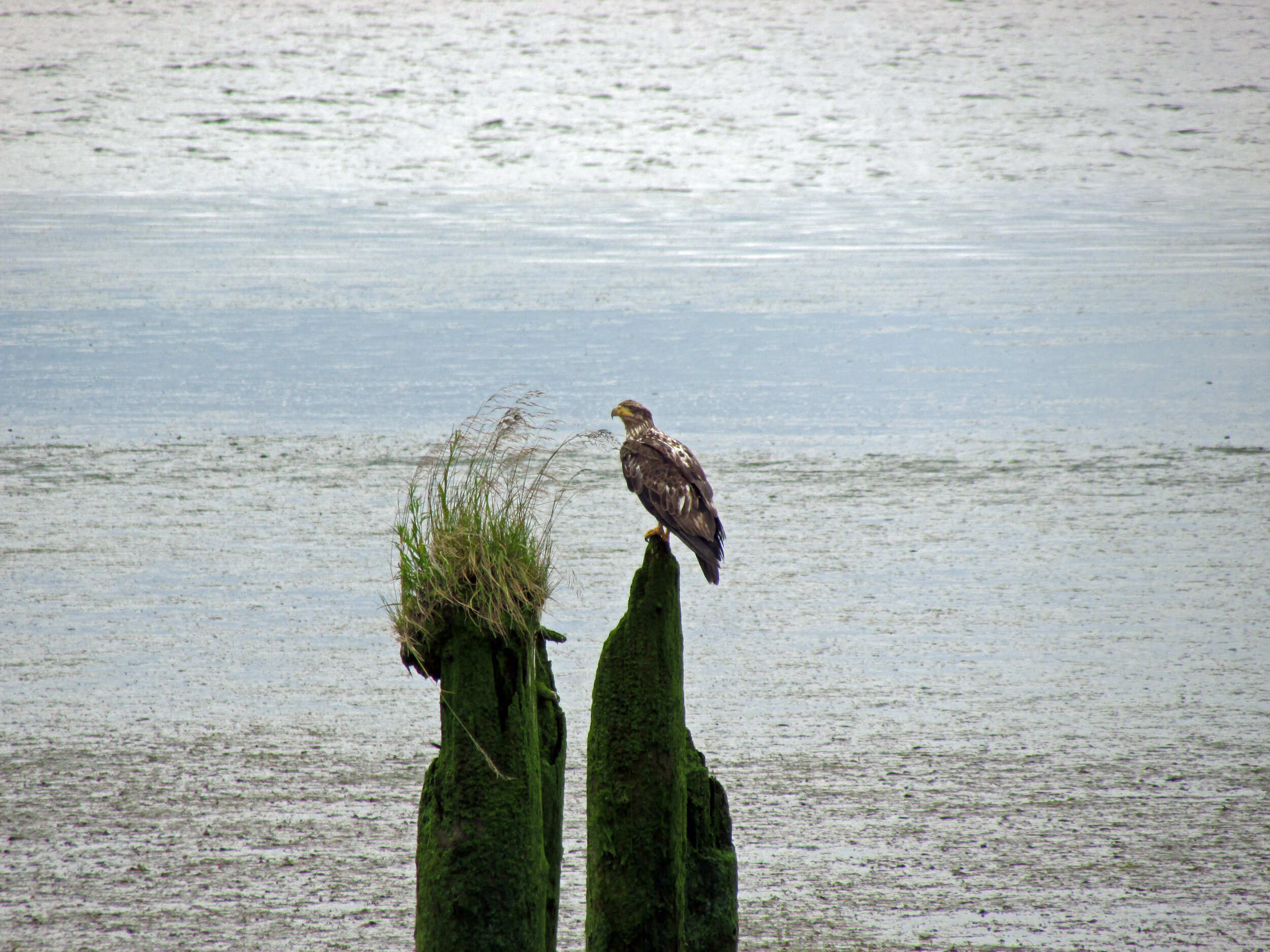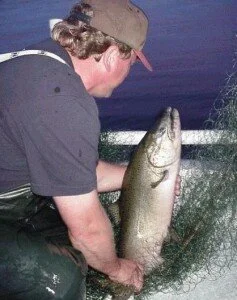
How it all began
Columbia River Commercial Fishermen: Fishing for the General Public
The Columbia River non-Indian commercial salmon fishery traces its roots back to the mid-19th century. Following the development of the salmon canning process, Columbia River salmon were introduced to a growing world market. The first Columbia River cannery was operated by the Hume family at Eagle Cliff, Wahkiakum County, Washington, in 1866. At the height of the salmon canning boom, there were 38 canneries on the lower Columbia River, 22 of which were in Astoria alone. But, following the boom-and-bust pattern typical of 19th century extractive industries, the cannery system was dramatically over-capitalized and excessively wasteful.
Jalmer Wilson of Astoria with a Chinook salmon weighing 82.5 pounds, caught on May 26, 1936, in the ship channel opposite Flavel Dock
By the 1880s, immigrant fishermen from Finland, Scandinavia, and the Mediterranean established new homes in the region, stabilizing the workforce, and organizing fishermen for mutual benefit, as well as to advocate for conservation of the fishery resource. Today’s Columbia River commercial fishermen are largely 3rd, 4th, 5th and 6th generation descendants of those early fishing families.
As the fishery grew, the fishing industry became proactive on behalf of the fish resource. Fishermen organized the Columbia River Fishermen’s Protective Union in 1884, and this group is still in existence today. Before the turn of the century, the industry called for the formation of fish commissions to regulate harvests. It also lobbied heavily for including fish ladders at Columbia Basin dams built in the 1930s and ’40s. In the early 1930's the Columbia River Fishermen's Protective Union filed and won the first anti-pollution lawsuit on the Columbia River, concerning the dumping of waste into the river by pulp and paper mills. This conservation measure was a groundbreaking strategy led by the gillnet fleet. In recent years, industry members have attended hundreds of meetings and served on scores of committees, commissions, and councils as part of the effort to solve the Columbia salmon crisis.
Columbia River Compact
As early as the 1870s, the states of Oregon and Washington initiated measures to regulate the fishery. However, conflicting regulations often hampered attempts to manage the resource. In 1915, the two states formed a bi-state Columbia River Compact, which Congress adopted three years later, making the two states co-managers of all Columbia River fisheries.
The Columbia River Compact and the Joint Management Staff of the Oregon and Washington Departments of Fish & Wildlife continue today as the principal management structure for all Columbia River fisheries, in consultation with NOAA Fisheries, the U.S. Fish & Wildlife Service, Idaho Fish & Game, the Treaty Tribes, and the Columbia River Intertribal Fish Commission. Much of the river is under concurrent jurisdiction.
The Columbia River salmon fishery today is one of the most highly regulated fisheries in the world. Strict conservation standards are upheld under the Endangered Species Act and the US v. Oregon accords, which adjudicate the treaty fishing rights reserved by the four Columbia River treaty tribes under the Treaties of 1855.
Development of the Columbia Basin
As the 20th century progressed, it became increasingly clear that prosecution of a full-scale commercial fishery was coming into conflict with the rapid development of the Columbia Basin. Mining, logging, grazing, irrigation diversions, and pollution all took their toll. But the biggest issue of all was degradation and loss of spawning and rearing habitat as ever greater portions of the basin were developed.
Today, the Columbia River basin only has about 40 percent of its original spawning habitat left, and much of that is degraded to one extent or another.
The Dammed Columbia
Even before the turn of the 20th century, the Columbia River system had lost significant portions of its original salmonid spawning habitat. As the 20th century progressed, dam building accelerated. Between 1900 and 1930, more than 100 dams were erected in the Columbia River basin. But, the 1930s marked the beginnings of the biggest player of all: the Columbia River Federal Power System. Nothing in the Columbia River Basin would be the same again.
Work began on Bonneville Dam in 1933. As originally planned, Bonneville was to be constructed without fish passage, which would have doomed all salmon runs in the mid- and upper Columbia basin, as well as those in the Snake River, the Columbia’s largest tributary.
Grand Coulee Dam
Fishermen from the Columbia River Fishermen’s Protective Union, along with Columbia River Packers Association executive Tom Sandoz, fought desperately to save the great river’s salmon from certain destruction. Thankfully, they carried the day. Fish ladders were installed at Bonneville Dam and began operating in 1938.
Unfortunately, the battle to save the salmon runs spawning above Grand Coulee Dam proved far more daunting. At over 500 feet in height, Grand Coulee was judged too tall for fish ladders. Attempts by the Grand Coulee Fish Maintenance Program to salvage the runs were only partially successful. Having cut off the upper third of the Columbia’s spawning habitat, the salvage effort focused on transforming the fish runs above Grand Coulee into composite, hybridized stocks suitable for artificial propagation and transfer to tributaries below the dam.
Hatcheries
Increasingly, as the 20th century progressed, artificial propagation of salmon in fish hatcheries came to be seen as a cure-all for habitat loss and blocked passage. Dam building and development held the promise of progress at the cost of the fish. Grand Coulee Dam was one of many built without fish passage facilities.
Federal funding for hatcheries via the Mitchell Act was the promise made to fishing-dependent communities that their livelihoods would continue when the federal hydropower system was built. Hatcheries themselves, however, encountered problems with rearing of fish and even jeopardized long-term survival of some runs of salmon. In the aftermath of the listing of nearly all the salmon stocks of the Columbia system under the Endangered Species Act, hatchery reform is now underway.
The limited harvest that is available is increasingly targeted on hatchery fish raised specifically for harvest. Of the “Four H’s” — Hydropower, Hatcheries, Harvest and Habitat — hydropower remains the biggest threat to recovery of the Columbia River’s salmon runs, and hardest for which to mitigate.
The Spring Chinook Fishery: Investing in Live-Capture Technology
Since 2000, Columbia River commercial gillnet fishermen have invested millions of dollars in live-capture fishing gear (tangle nets) and live-recovery boxes for the spring fishery. All participants in the commercial spring Chinook fishery must have attended state-sponsored training in the proper use of the new gear.
The tangle (or tooth) net is a 4-1/4² mesh net that works by entangling fish. Short net lengths, short soak times, and mandatory use of the live resuscitation box for bleeding or lethargic fish allow the fisherman to return unmarked (and presumably wild) spring Chinook to the river alive and in good condition. The mortality rate for fish released from tangle net gear has been calculated to be roughly comparable to the hooking mortality attributed to the sport fishery.
Chinook removed from tangle net
Test fishing is done on Sundays. Fishery managers schedule commercial openers when abundance of target stocks is high and presence of stocks of concern is low. During the 2008 spring season, three 12-hour commercial tangle-net openers were scheduled; 5,936 hatchery spring Chinook were retained, and 1,626 wild spring Chinook were released.


